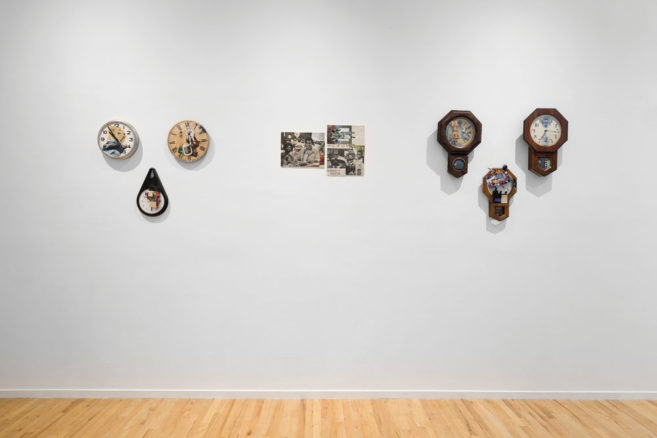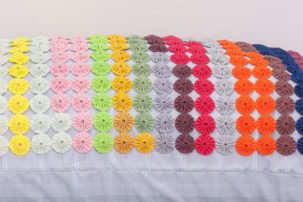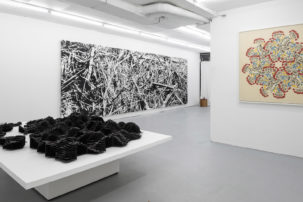Chewing gum brings oral pleasure—a combination of muscular movement, caressing of tongue and inner mouth as one masticates the wad, textural nuance, flavour and density/elasticity of the gum base, type and amount of sugar (saliva fusing with it to create a syrup that can cause squirting of the salivary glands). Another factor essential to the pleasure of chewing gum is how long the optimal flavour and texture lasts. When it’s bubble gum, pleasure relates to how well the tongue can penetrate the gum while pushing air through it, to create that expanding shiny bubble—how large the bubble can get before the diaphanous pink membrane bursts with a powdery or snappy poof. Most important of all is mouthfeel, which artists Hannah Jickling and Helen Reed call “the feeling of something touching the sides of your cheeks, your tongue, your teeth. A little more than texture—does it make your mouth water? Does it pop? Is it slimy?…it’s a slippery aesthetics, fuzzy authorship and tactile information that goes beyond our typical knowing.”
Jickling and Reed have spent the past four years on a research project, Big Rock Candy Mountain, with students at Vancouver’s Queen Alexandra Elementary School, turning the classroom into a candy factory. Through a pedagogical social practice, they engage students with non-traditional, extended notions of what art can be—a combination of research, workshops, taste testing (more than 30 types of gum), learning about the chemistry of “food” (comparing natural and synthetic gum bases and flavours), discussions with artists, learning about how marketing works through involvement in packaging design and brand concept, and so on.
The artists’ first highly successful project with students was the research and production of a chocolate bar, SOUR VS SOUR (2016). Their most recent unlimited-edition product, made with grade 6 and 7 students, is QA CHEW’S BUBBLE TROUBLE bubble gum—its light pink and lavender packaging covered in bubble-lettered epithets characterizing the gum, as well as invisible lettering that slips in transgressive behaviours to be enacted (e.g., sticking gum under the classroom desk). Like the chocolate bar edition, which included an adult’s preference and a child’s preference in one bar, two types of gum are included in the package: a natural chicle-based gum and a synthetic version, with a bouncier combination of polymers, waxes and softeners preferred by children. Flavours range from fruity (“berry-like”) to earthy (“smokey”), and texture from crumbly to extremely sticky.
BUBBLE TROUBLE was commissioned by the City of Vancouver, with the overall Big Rock Candy Mountain project supported over the years by Other Sights for Artists’ Projects. The gum was celebrated at a Halloween launch that coincided with Jickling and Reed’s exhibition “Mouthfeel” at Western Front. The exhibition featured many of the works introduced to students as part of the gum research in the classroom, with all of them displayed on a table in the shape of a giant mauve tongue, sticking out from the far wall. Dina Danish’s Brass Replica of Stone Age Chewing Gum (2013) is a scale model of one of the oldest pieces of chewing gum ever discovered—at 5,000 years old, it was originally made of birchbark tar, and bears the tooth impressions of its stone age “Finnish” chewer. Diane Borsato’s Artifacts in my Mouth (2003) shows a number of photographs of the artist interacting with museum objects (normally sequestered safely behind glass) by inserting them in her mouth—uncanny manifestations of the artist’s desire for alternative ways of getting to know things in the world. The exhibition included Salt Licks, reminiscent of Henry Moore’s biomorphic abstract sculptures, which had been altered/created by cow tongues licking the 50-pound cubes of salt and minerals. One could also find a gridded plastic tray of already-chewed gum, brown lumps punctuated by red, pink and blue wads—evidence of mouths-on research by the students. In the spirit of this student-led research project, already-chewed gum wads could also be found furtively stuck under the mauve tongue table.
How to engage elementary school students today using alternative pedagogical frameworks to talk about some of the essential questions plaguing the artist? What is art? Why make art? What can art afford? How to use quotidian experiences and commodity products against the grain as tools for learning, even those highly branded objects that have a hold over childhood desire? The Big Rock Candy Mountain project was not always popular with teachers. As artistic duo, Jickling and Reed in many ways embodied a kind of double trouble—troubling the framework of education by inserting fun into learning. The artists might have been seen as stealthy “parasites,” according to French philosopher Michel Serres, infiltrating the traditional disciplines of the classroom, creating new lines of communication against the grain and queering notions of knowledge—practices that are so essential for the next generation to develop new creative ways of being in the world. The chewing gum becomes a quasi-object, a kind of binding glue that circulates as shared knowledge exchange and collaboration between students with the aim of creating new types of relationships, experiences and ways of knowing, including understanding what is behind the seemingly banal yet desirable products that occupy our world.






